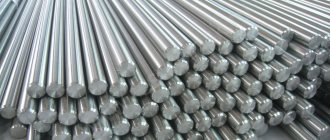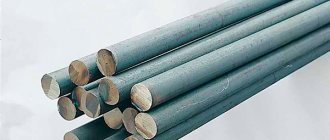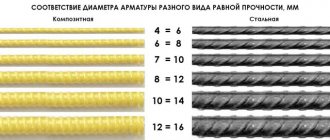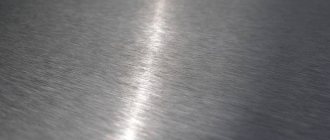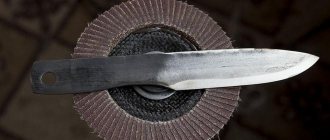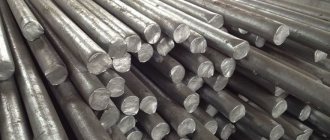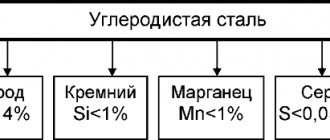Interpretation of VK8 steel
The name of the alloy stands for:
- B – use of tungsten in the composition;
- K8 – 8% cobalt.
92% of the material is tungsten carbide, the rest is cobalt. Depending on the grain size, the name of the VK8 alloy may contain other indices - M (fine), B (coarse). In the absence of an additional letter, the grain has a medium size.
Chemical composition and preparation
Cobalt is used to bind tungsten carbide. This is a metal similar in appearance to ferrum, but its shade is darker. Its use in the composition makes the alloy more malleable and durable. Tungsten carbide is a chemical compound of tungsten and carbon.
The composition of the VK8 alloy includes small fractions of a carbide compound and cobalt, which allows us to consider the material a product of powder metallurgy. To obtain them you need to perform several actions:
- grind the mixture;
- divide it into factions;
- mix the fractions in the required proportions;
- form the workpiece using a press and adhesive;
- process at a load of 30 MPa and a temperature of 1400 degrees.
As a result, moisture is released from the cobalt, which wets the part, and when this element crystallizes, carbide particles combine. The structure is characterized by strength and wear resistance.
Applications and products of hard alloys
The material is widely used in modern industry. The production technology of the alloys themselves is also developing, their quality is improving, the composition is changing, and new markings are appearing. But in addition to changing the material itself, the principles of working with it also change. New types of compounds applied to products are emerging, thanks to which they acquire new functions and roles in industry.
Today, hard alloys are used:
Before purchasing tools, parts, or simply raw materials that contain alloys, you must carefully study what class they belong to and what properties they have. This will help to understand the meaning of the markings, which indicate the composition of the product and, as a result, its ability to withstand certain loads. Each class of material is intended for use in a specific area of production and may be completely unsuitable for another, which should also be taken into account.
Source
Physical properties
Alloy VK8 is characterized by high hardness, which is not inherent in other materials. Temperature resistance allows it to be used at elevated temperatures, as well as at high tool rotation speeds, without the need for a break. This factor is positively influenced by thermal conductivity, which allows the cutter to rotate at a speed of 200 m per minute. Compared to P12 steel, this figure has become four times higher.
High technical characteristics guarantee preservation of performance under dynamic impact and vibration. The physical characteristics of the alloy are determined based on the chemical composition and grain structure size. As the size increases, strength and wear resistance increase.
Let's talk about cutters and TC inserts
Let's talk about cutters and TC inserts
Message #1 92rus » 28 Feb 2016, 01:39
Technique for cutting threads on a lathe
Post #2 Morpheus » 28 Feb 2016, 02:25
Technique for cutting threads on a lathe
Post #3 chkmatulla » 28 Feb 2016, 03:09
Technique for cutting threads on a lathe
Message #4 Grisha » February 28, 2016, 2:21 pm
Technique for cutting threads on a lathe
Post #5 chkmatulla » 28 Feb 2016, 14:42
Technique for cutting threads on a lathe
Message #6 Denis# » 28 Feb 2016, 14:46
Technique for cutting threads on a lathe
Post #7 chkmatulla » 28 Feb 2016, 14:47
Technique for cutting threads on a lathe
Message #8 Grisha » February 28, 2016, 2:50 pm
Sent 1 minute 43 seconds later:
Source
Application area
VK8 hard alloy is used in various fields of activity, which include medicine and jewelry. Tools made from this material are wear-resistant and practically do not wear out when cutting metal. Maintaining performance characteristics is possible at heating temperatures up to 1100 degrees, and the following treatment is used:
- mechanically;
- chipless;
- gas thermal spray.
The use of VK8 alloy is intended for the manufacture of tools:
- wear parts;
- rolling shafts, punches, stamping molds, calibration equipment;
- turning, drilling, milling, countersinking tools;
- products for finishing and roughing work with titanium alloys, steel with high anti-corrosion properties, temperature resistance, cast iron, brass, bronze.
To increase the speed of work and reduce wear, the metal grain size is taken into account when choosing a tool. The coarse-grained material is used for roughing heat-resistant steels. Fine grain allows you to create a fine surface on steel, cast iron, fluoroplastic, aluminum and bronze.
Gas thermal spray is used to increase the resistance of parts to wear.
Elements are manufactured in the form of soldering or replaceable plates. They are mounted on a cutting tool holder made of structural steel using bolts and studs. Mechanical parameters are improved by surface treatment. For example, the tensile strength of the plate increases when grinding with a diamond wheel, which also has a positive effect on service life and wear resistance.
Specifications
The main characteristics of the VK8 alloy include:
| thermal conductivity | 50.2 W/mK; |
| heat resistance | 800-1000 degrees Celsius; |
| processing pressure | 30 MPa; |
| viscosity | 35 kJ/m2; |
| coefficient of friction in water | 0,01; |
| Rockwell hardness | 88; |
| specific gravity | 14800 kg/m3; |
| tensile strength | 1666 MPa. |
How to choose the right grade of carbide.
Metal-ceramic hard alloys are divided into two groups:
— Titanium-tungsten alloys “TK” (they are used to process steel materials and products);
— Tungsten alloys “VK” (with their help, non-ferrous metals and alloys, cast iron materials and non-metallic products are processed).
In turn, these two groups are divided into grades of hard alloys. They have their own distinctive features (properties), which determine the conditions and areas of use of this brand. The properties of each grade of hard alloys are designed so that the manufactured products can support production in any industry.
It is very important to choose the right grade of hard alloy for each type of work performed. This factor is very important and is one of the main ones; it cannot be neglected; the speed and quality of the work performed depends on it.
When choosing an alloy grade, you should proceed from the following basic conditions:
— Physico-mechanical and operational properties of hard alloys; — Characteristics of the processed material;
— Technical conditions of processing and its type; — The nature of the requirements for processing accuracy and cleanliness of processed surfaces;
— The state of the machine and its kinematic and dynamic data.
Table of physical and mechanical properties of hard alloys and its chemical composition.
| Alloy (group) | Alloy grade | Theoretical composition of the alloy (without taking into account the presence of impurities), % | Physical and mechanical properties | ||||
| Wolfram carbide | cobalt | titanium carbide | bending strength, kg/mm 2 not less | specific gravity | Rockwell hardness, scale A, not less | ||
| Tungsten | VK2 | 98 | 2 | — | 100 | 15,0-15,4 | 90,0 |
| VK3 | 97 | 3 | — | 100 | 14,9-15,3 | 89,0 | |
| VK6 | 94 | 6 | — | 120 | 14,6-15,0 | 88,0 | |
| VK8 | 92 | 8 | — | 130 | 14,4-14,8 | 87,5 | |
| VK11 | 89 | 11 | — | 150 | 14,0-14,4 | 86,0 | |
| Titanium-tungsten | T5K10 | 85 | 9 | 6 | 115 | 12,3-13,2 | 88,5 |
| T14K8 | 78 | 8 | 14 | 115 | 11,2-12,0 | 89,5 | |
| T15K6 | 79 | 6 | 15 | 110 | 11,0-11,7 | 90 | |
| Т15К6Т | 79 | 6 | 15 | 110 | 11,0-11,7 | 91 | |
| T30K4 | 66 | 4 | 30 | 90 | 9,5-9,8 | 92,0 | |
| T60K6 | 34 | 6 | 60 | 75 | 6,5-7,0 | 90,0 | |
Comparative performance properties of hard alloys.
Tungsten grades of hard alloys:
VK2 is the hardest, wear-resistant and heat-resistant of all tungsten group alloys;
VK3 – high wear resistance and hardness, but slightly lower than that of the VK2 alloy;
VK6 – lower wear resistance and hardness than alloy VK3, with greater operational strength;
VK8 – high operational strength and resistance to shock, vibration and chipping, with less wear resistance and hardness than the VK6 alloy;
VK11 is the most durable of all the above tungsten hard alloys. Lowest hardness and wear resistance. It is used when processing special hard-to-cut materials.
Titanium-tungsten grades of hard alloys:
T5K10 – the highest operational strength for titanium-tungsten alloys. Less hard and wear-resistant than T14K8 alloy;
T14K8 - Greater hardness, wear resistance and heat resistance than the T5K10 alloy, with slightly lower operational strength;
T15K6 – greater hardness, wear resistance and heat resistance than the T14K8 alloy, with lower operational strength;
T15K6T – greater hardness and wear resistance than the T15K6 alloy, with slightly reduced operational strength;
T30K4 – high hardness, wear resistance and heat resistance, with significantly reduced operational strength;
T60L6 is the most wear-resistant and heat-resistant of all titanium-tungsten group alloys, with the lowest operational strength.
Below you can find a table of recommendations for choosing grades of hard alloys depending on the type, nature and processing conditions, as well as on the material being processed. However, there may be cases in which, due to the specific nature of the operation, application conditions or material being processed, this table will not be sufficient.
Carbide alloy VK8
How to increase the speed of steel cutting? Engineers and professors around the world have worked and continue to work on solving this issue since the Industrial Revolution. High levels of hardness, heat resistance, wear resistance - this is an incomplete list of tasks facing scientists. Thus, in Germany in the mid-30s, research was actively carried out to find material that met all of the above requirements. Then the first analogue of the VK8 hard alloy appeared. Samples of this material surpassed all types of steels existing at that time in cutting speed. What was the reason for this success? What is the chemical composition? What, in the end, does the decoding of VK8 look like? Let's talk about all this in order.
Grades of hard alloys: classification of materials
Hard alloys are classified according to two main criteria.
Method of obtaining
According to the method of production, hard alloys are divided into two types.
Cast. They are made using casting technology. Alloys of this group include stellites, sormites, and hard alloys with a high nickel content. Typically, pressing and thermal post-processing (hardening, aging, annealing, etc.) are used in production. The result is high quality materials. Cast carbide alloys are intended for surfacing on metalworking tools.
Sintered. Such hard alloys are also called metal-ceramic due to the fact that the manufacturing technologies are very similar. The materials are produced using powder metallurgy technology. It is supplemented by laser/ultrasound processing or acid etching. The resulting materials are of the highest quality.
Sintered carbide alloys are fixed to tools mechanically or using soldering technology.
Chemical composition
Based on their chemical composition, hard alloys are divided into 4 groups.
Single carbide (tungsten-cobalt). Marking - VK.
Two-carbide (titanium-tungsten-cobalt). Marking - TK.
Tricarbide (titanium-tantalum-tungsten-cobalt). Marking - TTK.
Tungsten-free. Marking - TN.
Chemical composition and method of preparation
According to GOST 3882-74, the VK8 hard alloy is a mixture of tungsten carbide and cobalt grains, acting as a connecting link. Cobalt (GOST 123-2008) is a metal similar in appearance to iron, but has a darker shade. Its main purpose in VK8 is to impart ductility and strength to the alloy. Tungsten carbide (GOST 28377-89) is a compound of carbon with the refractory metal tungsten. Hardness - over 80 Rockwell units.
VK8 is a product of powder metallurgy, since the above properties of the constituent elements do not allow mechanical processing by forging. The production of fine fractions of carbide and cobalt is carried out by reduction from oxides and includes the following operations:
- Crushing the mixture of structural components.
- Sifting through a sieve with a mesh size of 1-2 microns.
- Mixing fractions in proportions according to the required chemical composition of the VK8 hard alloy.
- Pre-shaping by pressing using organic glue.
- Treatment with pressure over 30 MPa and temperature of 1400 ºС.
As a result of these processes, the molten cobalt wets and, during subsequent crystallization, holds the carbide crystals together. As a result, a strong and wear-resistant connection is formed.
Physical properties
VK8, unlike high-speed steels, has greater hardness, which corresponds to 87.5 HRC units. As an example, P12 steel has only 60-70 HRC.
The heat resistance of the alloy, i.e. the temperature at which the material will work without losing rigidity, is 800-1000 ºС. Thanks to this and the high thermal conductivity value (50.2 W/m C), the VK8 cutter can operate at cutting speeds of up to 200 m/min, depending on the type of material being processed. Whereas under the same conditions, P12 steel allows one to achieve a value of only 50 m/min.
Tensile strength 1660 N/mm2, density 14.5 g/cm3, impact strength 35 kJ/m2 - these mechanical properties make it possible to use the alloy under conditions of dynamic and vibration loads.
Physical properties are determined not only by its chemical composition, but also by the grain size of tungsten carbide. The larger the grain, the higher the strength reading and the lower the wear resistance value. And vice versa, if the alloy has a fine-grained structure.
Classification
Like any metallic materials, hard alloys have their own classification, which helps you choose the most suitable material for your purposes.
Depending on the method of production, alloys are:
As the name suggests, cast alloys are produced by casting technology. Among them: stellites (which consist of chromium, tungsten, carbon and nickel; cobalt is used as a binder), sormites (consisting of chromium, carbon and nickel on an iron base), as well as hard alloys in which nickel is used as a base. Most often, the casting process uses press technology, which allows for high quality products that require minimal processing before use (however, thermal post-processing is most often necessary).
Sintered alloys (or metal-ceramic), in turn, are produced using powder metallurgy technology. It is a high-precision production, due to which the resulting material has the highest possible quality and does not require additional processing. The maximum that may be required is a little polishing of the resulting product. These alloys are called metal-ceramic because the method of their production is similar to the production of ceramic products.
According to their chemical composition they are distinguished:
Tungsten-cobalt
Alloys based on tungsten carbide are the most common representatives of this group. These include BK6 and BK8 mentioned above. Alloys can be divided into two more groups, depending on their composition: containing tungsten - as mentioned earlier, such alloys consist of tungsten carbide and at least one more metal that plays the role of a binder (most often cobalt).
VK group alloys are mainly used for the manufacture of cutting tools. These are cutters and plates.
Composition and characteristics of VK alloys
Characteristics of physical and mechanical properties
Bending strength
Such materials produce high-quality tools that are used in industry, various industries and in everyday life, and for the manufacture of parts of various designs. These can be parts for cars, mechanical objects, instruments and any mechanisms. production of parts requiring high heat resistance.
Titanium-tungsten-cobalt
The TK group of alloys is produced for tools that cut steels that produce flush chips. The composition is based on titanium carbide and tungsten carbide. The bond is cobalt. Titanium reduces adhesion to steel, making TK group alloys more wear-resistant when processing steel. As titanium carbides increase, hardness and wear resistance increase, but strength decreases.
Characteristics of physical and mechanical properties
Tensile strength at
Titanium-tantalum-tungsten-cobalt hard alloys
According to GOST 3882-74 there are 5 grades. Titanium in the composition improves properties and performance indicators, expressed in increased strength at normal and elevated temperatures. Tantalum carbide in the composition improves wear resistance when cutting
Characteristics of physical and mechanical properties
Tungsten-free alloys
Such alloys appeared in the USSR in the 1970s. due to a shortage of tungsten. According to GOST 26530-85, there are two grades of tungsten-free alloys based on carbides and titanium carbonitrides with a nickel-molybdenum binder.
Contents of main components
These grades have less strength and heat resistance; they cannot replace traditional tungsten. Alloy KNT16 is well suited for intermittent cutting. And the TN20 brand can effectively replace T30K4 and T15K6. They can be used for finishing and semi-finishing of non-hardened steel.
One way or another, due to their properties, alloys are widely used in many industries.
According to the ISO classification, carbide alloys are divided into areas of application in cutting:
Alloys of group P are marked in blue, M - yellow and K - red
Interpretation of VK8 steel
The designation is based on the presence of a carbide phase and a binder in the form of cobalt in the composition. In general, it is similar to the encryption of alloy steels. The letter “B” stands for tungsten, “K” for cobalt. The number at the end determines the percentage of the last element. So, VK8 consists of 92% tungsten carbonate and 8% cobalt.
To indicate grain size, they can put the letter “M” at the end, which means fine-grained, or “B” - coarse-grained. The absence of a letter indicates the presence of medium-sized grain in the composition.
Scope of application VK8
VK8 is widely used in various types of production, from medicine to jewelry. Cutting tools made from this carbide are highly resistant to abrasion by the workpiece material. They do not change their physical structure and maintain performance characteristics up to a temperature of 1100 ºС, unlike tool and high-speed steels. Because of this, VK8 has received the greatest use in the following production operations:
- Mechanical processing of parts. Manufacturing of turning tools, milling cutters, drills, countersinks. The technological operations performed by this tool are suitable for both roughing and finishing work. VK8 has proven itself in processing materials with a high viscosity coefficient: bronze, brass, cast iron, heat-resistant steels, corrosion-resistant steels, titanium alloys. It should be noted that in order to ensure better cutting speed and reduce wear on the working tool, it is necessary to take into account the grain size of the alloy. Coarse-grained alloy VK8 is used in conditions of rough, rough turning of heat-resistant steels and a significant feed rate of the cutter. The fine-grained structure of the material is used for finishing processing of steel (without heat treatment), cast iron, fluoroplastic, aluminum and bronze parts.
- Chip-free processing. They produce rolling equipment rolls, punches and dies for stamping non-ferrous metals, calibrating pipes and rods.
- Gas thermal sprayer. Applying it to the surface of parts of any type of steel increases its wear resistance.
- Wearing parts of mechanisms and machines. For example, as a material for sleeve bearings. Provided there is fluid friction, it operates at spindle speeds of up to 6 m/s.
Carbide materials are supplied in the following types: soldered (or glued) plates and replaceable ones. The latter are attached to the cutting tool holder with a threaded connection. In order to save money, normal quality structural steel is used to make the holder.
With the help of additional operations, the mechanical properties of the incisors can be improved. Thus, the VK8 plate increases its tensile strength by 23% after treating its surface with diamond grinding. Accordingly, the service life and stability of operation increases.
Application of VK8
VK8 hard alloy is used for rough work:
- grinding down inhomogeneities on cut sections;
- drilling holes;
- planing;
- milling works;
- countersinking of gray cast iron.
With its help, the surfaces of all types of steels are processed: alloyed, cast iron, heat-resistant; hard wood.
Rough turning with uneven cut section and intermittent cutting, planing, rough milling, drilling, rough drilling, rough countersinking of gray cast iron, non-ferrous metals and their alloys and non-metallic materials. Processing of corrosion-resistant, high-strength and heat-resistant difficult-to-machine steels and alloys, including titanium alloys.
Alloy VK8 GOST 3882-74 was installed back in the USSR - (view / download GOST). With the same percentage of tungsten, it has physical properties that differ significantly from similar ones that do not fall within the framework of a specific GOST.
GOST 3882-74 with information about VK8 alloy and other grades of hard alloy - click on the picture to view GOST
Tool carbide alloys
Home / Directories / Tool hard alloys
Hard alloys of standard grades are made on the basis of tungsten, titanium and tantalum carbides. Cobalt is used as a binder.
Depending on the composition of the carbide phase and binder, the designation of hard alloys includes letters characterizing the carbide-forming elements:
- B - tungsten
- T - titanium
- TT - (second “T”) tantalum
- K - cobalt
Mass fractions of elements are expressed as a percentage, their sum is 100%. For example, grade VK8 (single-carbide alloy) contains 8% cobalt and 92% tungsten carbides; grade T5K10 (two-carbide alloy) contains 5% titanium carbides, 10% cobalt and 85% tungsten carbides; grade TT8K6 (three-carbide alloy) contains 6% cobalt, 8% titanium and tantalum carbides, 86% tungsten carbides.
Properties and applications of hard alloys
| Alloy grade | Bending strength, MPa, not less | Density g/cm3 | HRA*, no less | Application area |
| Tungsten alloy group | ||||
| VK3 | 1176 | 15,0-15,3 | 89,5 | Finishing and final processing (turning, threading, dimensional machining of holes, etc.) of gray cast iron, non-ferrous metals and alloys and non-metallic materials |
| VK3-M | 1176 | 15,0-15,3 | 91,0 | Finishing (turning, boring, threading, reaming) of hard, alloyed and bleached cast irons, cemented hardened steels |
| VK4 | 1519 | 14,9-15,2 | 89,5 | Roughing with an uneven cut section (turning, milling, boring, drilling, countersinking) when processing cast iron, non-ferrous metals and alloys, titanium and its alloys. |
| VK6 | 1519 | 14,6-15,0 | 88,5 | Roughing and semi-finishing (turning, threading with cutters, milling, drilling and boring, countersinking of holes) of gray cast iron, non-ferrous metals and their alloys. |
| VK6-M | 1421 | 14,8-15,1 | 90,0 | Semi-finish machining of heat-resistant steels and alloys, corrosion-resistant austenitic steels, hard cast irons, hardened cast irons, hard bronze, light metal alloys, machining of hardened steels, as well as raw carbon alloy steels with thin cut sections at very low cutting speeds |
| VK6-OM | 1274 | 14,7-15,0 | 90,5 | Finishing and semi-finishing of hard, alloyed and bleached cast irons, hardened steels, high-strength and heat-resistant steels, steels and alloys based on titanium, tungsten and molybdenum (turning, boring, threading, scraping) |
| VK8 | 1666 | 14,4-14,8 | 87,5 | Roughing with uneven cut section and intermittent cutting of gray cast iron, non-ferrous metals and their alloys, corrosion-resistant, high-strength and heat-resistant steels and alloys, titanium alloys (turning, planing, milling, drilling, countersinking) |
| VK10-OM | 1470 | 14,3-14,6 | 88,5 | Roughing and semi-finishing of hard, alloyed and bleached cast irons, corrosion-resistant, high-strength and heat-resistant steels and alloys, especially alloys based on titanium, tungsten and molybdenum. Manufacturing of monolithic tools. |
| VK10-M | 1617 | 14,3-14,6 | 88,0 | Processing of steel, cast iron, some grades of difficult-to-cut materials and non-metals with solid carbide small-size tools (drilling, countersinking, reaming, milling and gear hobbing) |
| VK10-HOM, VK15-HOM | 1500, 1650 | 14,3-14,6, 13,8 | 89,0 87,5 | Semi-finishing and finishing processing of heat-resistant steels and alloys, mainly by turning. |
| Titanium-tungsten group of alloys | ||||
| T30K4 | 980 | 9,5-9,8 | 92,0 | Finishing of unhardened and hardened carbon steels (turning, threading, reaming) |
| T15K6 | 1176 | 11,1-11,6 | 90,0 | Semi-finish turning (continuous cutting), fine turning (interrupted cutting), thread cutting with cutters and rotating heads, semi-finish and fine milling of solid surfaces, boring, fine countersinking, reaming when processing carbon and alloy steels |
| T14K8 | 1274 | 11,2-11,6 | 89,5 | The same as for alloy T15K6, as well as roughing with uneven cross-section and continuous cutting |
| T5K10 | 1421 | 12,4-13,1 | 88,5 | Rough turning and milling with uneven sections and intermittent cutting, shaped turning, cutting with cutters, finishing planing and other types of processing of carbon and alloy steels, mainly in the form of covers, stampings and castings on crust and scale |
| T5K12 | 1666 | 13,1-13,5 | 87,0 | Heavy rough turning with uneven cross-section of steel covers, stampings and castings along the crust with cavities in the presence of sand, slag, etc.; all types of planing, drilling of carbon alloy steels |
| Titanium-tantalum-tungsten group of alloys | ||||
| TTK12 | 1666 | 13,0-13,3 | 87,0 | The same as for T5K12 alloy, with the exception of drilling steel. Heavy rough milling of carbon and alloy steels |
| TT8K6 | 1323 | 12,8-13,3 | 90,5 | Fine and semi-finish turning, boring, milling and drilling of gray, malleable and bleached cast iron. Continuous turning with small sections of cut steel castings, high-strength corrosion-resistant steels, including hardened ones. Processing of non-ferrous metal alloys and some grades of titanium alloys when cutting with small and medium cut sections |
| TT20K9 | 1470 | 12,0-12,5 | 91,0 | Milling of steel, especially deep grooves, and other types of processing that impose increased requirements for resistance to alloy thermal and mechanical cyclic loads |
| TT10K8-B | 1617 | 13,5-13,8 | 89,0 | Roughing and semi-finishing of corrosion-resistant austenitic steels, low-magnetic steels, heat-resistant steels and alloys, titanium alloys |
*HRA - Rockwell hardness (scale A)
Where does the difference come from and what causes it?
The tabular characteristics of the VK8 alloy are achieved in production most often by powder metallurgy methods. Individual elements of future equipment are pressed into molds and sintered at the melting temperatures of cobalt. As a result, fairly reliable plates for cutters and drills are obtained.
The decoding of the VK8 alloy is simple: the content of tungsten carbide is 92, cobalt is 8% and is always maintained as such for a specific marking. Sometimes this composition is mistakenly attributed to Pobedit (90/10), but the difference of 2% is fundamental for tungsten compounds.
Hard alloy grades
Content
Hard alloy grades
Hard alloys of various grades are a group of wear-resistant metal materials that retain their properties at temperatures from 900 to 1150 °C. The main components of such alloys are tungsten, tantalum and titanium carbides.
These carbides are brittle. Therefore, binder metals are used to form hard alloys. These are cobalt, nickel and molybdenum.
Photo No. 1: carbide blanks
Metal blockages
Sometimes they take any hard alloy within the VK8 alloy grade. It is quite highly valued, but there is no single price on the market. An expert can tell you the exact price after examining the product.
In addition to the listed differences, there is added a factor associated with the type of metal connection of elements from VK8 with the base of the product.
Cutters with inserts made of VK8 alloy
The mounting methods are fundamentally different. The output is either pure tungsten/cobalt after mechanical fastening with screws or with soldering of brass and other connecting metals. Preference is always given to pure metals, however, given the metallurgical industry's shortage of tungsten and cobalt, the desire to reduce the production of ores containing these chemical elements is accepted by almost all types of alloys, but at different prices.
Foreign analogs of VK8 alloy
| Germany | Sweden | Bulgaria | Hungary | Poland | Czech |
| DIN,WNr | SS | BDS | MSZ | PN | CSN |
| HG30, HG40 | MC241 | BK8 | DR30, DR40 | H30 | G1.1, G2 |
Area of use of tungsten-containing products
The use of VK8 alloy , like other similar types of vehicles, extends to various industries where it is necessary to drill wells in abrasive rocks, cut marble, harvest coal, and process granite. Tungsten products are also used in mechanical engineering for the manufacture of friction pairs for bearings, dies, and molds.
Special carbide elements (teeth) are installed on the cutters of the bits and on the paws - one of the most commonly used alloys is VK8
Already today, this type of metal has found an area of application - especially durable coatings created by spraying technology. The most famous alloy VP3325 is made on its basis; it improves the properties of brittle joints with the following qualities:
- thermal conductivity, hardness;
- elastic modulus;
- impact strength;
- resistance to vibration.
VP3325 alloy plates
Meanwhile, this type of processing of low-strength materials is becoming increasingly popular and is used in medicine, optics, and the jewelry industry. This approach to instrumentation simultaneously reduces the cost of production, as well as the need for tungsten. Thanks to the possibility of using recyclable materials, some even foreign enterprises are provided with resources without additional extraction from the bowels of the earth.

